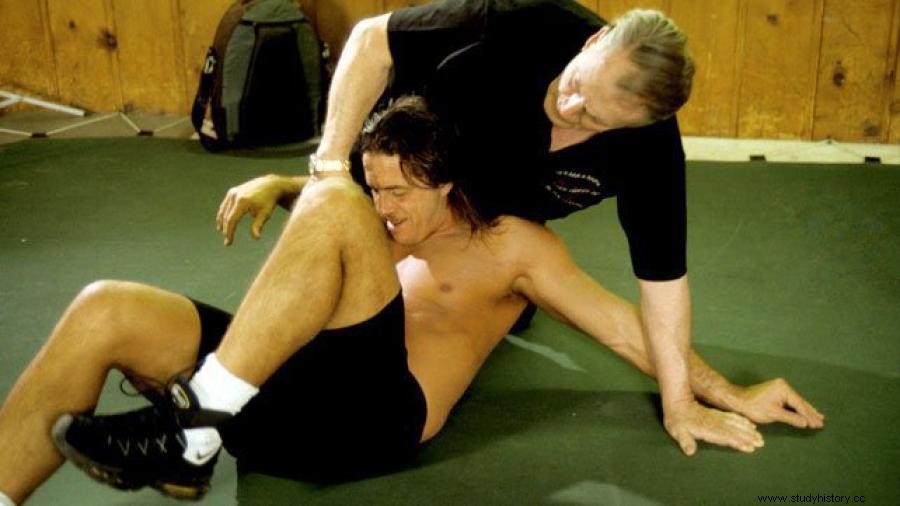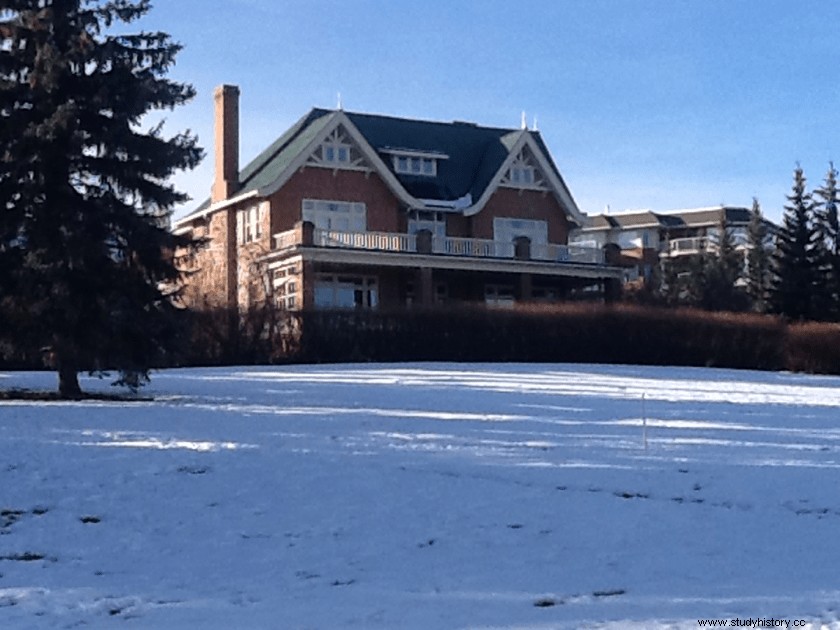Located in the Patterson Heights area of Calgary is an old, large mansion. Surrounded by other luxury homes, the brick house offers stunning views of the city skyline. This house was built in 1902, making it one of Calgary's oldest landmarks. The house has a historical history:it served as a military hospital for wounded soldiers during the First World War, and later operated as an orphanage in 1920. But the house is known for something else. It was the home of the Hart wrestling family for 52 years.
The Hart Family
Almost everyone who lived in Calgary from the 1960s to the 1990s knows who the Hart family is. Led by Patriarch Stu Hart, the family grew to become one of the best professional wrestling families in Canada and the world. Stu and his wife Helen raised 12 children:eight boys and four girls. Every child would be involved in the pro-wrestling business in one way or another. Each of the boys either fought, booked or judged. All four daughters wanted to marry wrestlers. Some of their children would grow up to be wrestlers as well; a few would even fight in the WWE. For his achievements, Stu was received by the Order of Canada.

Stamped wrestling
From 1948-1984, Stu Hart ran the professional wrestling campaign Stampede Wrestling. It was one of the main campaigns in all of Western Canada. The campaign ran shows all the time in Alberta, Saskatoon, and into Montana. For many years, the campaign would be successful. Arenas in Calgary, Edmonton, Regina, would be sold out with fans eager to absorb the excitement. Famous stars like Andrè The Giant would earn time in the campaign to help draw attendees. Stu also built a strong list of homemade talents.
Stampede Wrestling produced one of the earliest TV professional wrestling programs. Today, this program is considered the forerunner of current WWE programming. Stampede's programming remained one of Calgary's most popular sports programs, eventually airing in over 50 countries.
Despite its initial success, the campaign steadily lost money in the early 1980s. The death blow came in 1983 when a riot broke out during a fight at Calgary's Ogden Auditorium. As a result, Calgary's wrestling and boxing commission banned Stampede Wrestling for six months. These events greatly drained what was left of Stampede's economy.
In 1984, Stampede Wrestling was acquired by WWF owner Vince McMahon. The new ownership was short-lived. Vince sold Stampede back to Harts in 1985. The family wanted to run the new campaign for the closed store in December 1989. Afterwards, Stampede would be revived again and again for several years. The campaign finally closed for good in 2008.
Hitman and the rocket
The two most famous Hart children are Bret and Owen. In the mid to late 1990s, Bret "Hitman" Hart was the top star of the then World Wrestling Federation. Bret would become even more famous or infamous for the 1997 Montreal Screwjob:a ploy by the WWF to "steal the championship belt" from Bret.
After siblings, younger brother Owen "the Rocket" was a prominent star in the company. One of the biggest stories in WWF in the 1990s was the sibling rivalry between Bret and Owen. This rivalry would incorporate the parents, siblings and in-laws into different battles.
Later in the decade, a wrestling stable would be formed consisting of the two brothers and their in-laws. The stable was called The Hart Foundation, and they would be involved in many major feuds. The stable would boast of their nationalism and often waved a Canadian flag as they entered the arena and condemned American and American wrestling fans.
Tragedy
However, the tragedy would hit the Hart family. In 1999, Owen would tragically die in a failed stunt during the ring entrance of a WWF show. Three years later, in-laws Davey Boy Smith died of a heart attack at the age of 39. That same year, Bret suffered a stroke in a bicycle accident. With intense physiotherapy, he was able to walk and talk again.
Despite these tragedies, the Hart family is still going strong. Loyal fans remember the family for their great wrestling moments. Owen Hart's memory is celebrated by millions of breaking fans. And in 2006, Bret Hart was inducted into the WWE Hall of Fame. This secures his status as one of the greatest wrestlers of all time.
The House
Stu bought the house in 1951 for a sum of $ 25,000 XNUMX. The mansion featured 22 rooms, four fireplaces, five chandeliers from the McDonald Hotel and a bus house. It was perfect for the large family Stu planned. Besides the 12 children, the house was home to several vintage Cadillacs and animals, such as dogs, cats, cows, horses, chickens and even a bear named Terrible Ted who lived under the porch.
The house was also the headquarters of Stampede Wrestling. In his office, Stu wanted to plan the week's upcoming matches. If there were any problems with a match, Stu and his wrestlers would meet at home to find out. Helen also wanted to work tirelessly in the office, keeping track of finances, answering telephones and organizing other important documents.
On payday, wrestlers would drive up to the house to pick up their check. And when business was good, Stu invited most of the roster up to the house for a meal. There they ate, drank and fought each other in the basement. Over the years, the house has gained a reputation with them in the professional wrestling community.
Outside of professional wrestling, political and entertainment figures would pass through the doors of Hart House, usually during a wedding at home.
The dungeon

Hart House is best known for its basement. As soon as Stu bought the house, he began to expand the interior. This included building a gym in the basement. The gym consisted of a single room and contained a wrestling mat along with weights and machines. It was a place where Stu could train and fight against future stars, as he did for 40 years.
The basement was later nicknamed "Dungeon". The room became known for the intense training that took place in it. Stu was known as a submission switch, and took great pride in "stretching" switches:distorting and stretching the switch's body until they screamed in pain. The dark, humid atmosphere in the room only increased the Dungeon's frightening pressure.
It was in the dungeon where Bret, Owen and their brothers learned to fight professionally. In addition to training his sons, Stu made the Dungeon a training school for professional wrestling. Many famous wrestlers wanted to learn their craft in the basement, such as Jake "the Snake" Roberts. After Stu retired, the sons continued to run the school until the ownership of the home changed hands.
Today, having trained in the dungeon carries a certain level and status. It signaled to others that you survived a tiring training program, and became tougher and more resilient because of it. As a granddaughter, Natalya Neidhart says, "If you could survive the dungeon, you could survive anything."
End of an era
In 2001, Helen died. She was accompanied by her husband Stu when he passed away in 2003. After the parents' death, the Hart children discussed what to do with the childhood home. It was about turning the house into a museum or a bed and breakfast. However, these changes will lead to the house losing its protective status. The resin final made the difficult decision to put the home on the market. Several trips home were given to potential buyers. But no one seemed interested in buying the historic home.
The following years found the house in danger. In 2006, conservation plans ended with a tie in the city council. This left the house in danger of demolition. So in 2007 a revised plan called for restorations to be done on the house. Thirteen new townhouses were also constructed on the surrounding property. However, the restorations did not take place, and three years later the house was put up for sale for $ 5 million dollars and an associated development permit. No offers were received. Finally, in 2012, the City of Calgary Hart House designated a municipal cultural monument. The event also saw nine houses with secondary suites built on the property.
As of 2017, the house has been restored and available for rent for $ 10,000 XNUMX a month.
Calgary Icons

Some may wonder why Hart House is so important. After all, professional wrestling is a bit of a niche sport, and it does not get as many fans as the other professional sports (namely hockey) do in Calgary. However, Hart's were and remain important representatives of the city. Undoubtedly, Hart's has brought as much exposure to Calgary as the Calgary Flames has.
Bret and Owen fought in the WWF during the 1980s and 1990s. This is a time considered the boom period for the company; the era with the most fans watching or attending events. And throughout the term, Hart's was always billed from Calgary, Alberta Canada.
This is an important distinction. Often, switches, names, and origins would be constantly changing to adapt to the character's personality. But not Hart's. Bret and Owen will always be billed as proud callers. When Bret Hart became WWF Champion in the 1990s, his connection with Calgary became even greater. WWF even hosted a pay-per-view event in Calgary during Stampede 1997. The Hart's was rightly featured in the main event, and received a welcome in its hometown.
This strong connection to his hometown ensured that Hart was a fan favorite, not only in Calgary but also in Canada. In some ways, Hart's helped put Calgary on the map. When discussing the history of Calgary, Harts must be involved. And Hart House is where it all began. It is a symbol of the success of Canada's wrestling family.
Harthuset today
Today, Hart House is still at the top of Patterson Heights. The house was once visible to drivers on their way down the motorway towards Banff. Now it is hidden by the many houses and apartments built in the surrounding area. Although not open to the public, fans can drive or bike up to the neighborhood and take a picture of the mansion from the outside. Other wrestlers have traveled to the house to pay homage to the holy home.
Although the house is still a municipal heritage, I hope Calgary will eventually turn Hart House into a museum. Hart House is not only part of Calgary history, it is part of Canadian history as well.

